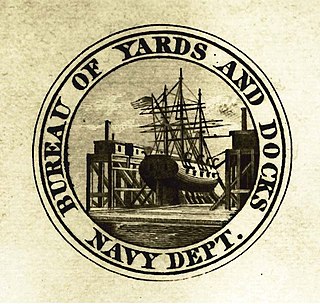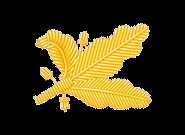Related Research Articles
The Bureau of Aeronautics (BuAer) was the U.S. Navy's material-support organization for naval aviation from 1921 to 1959. The bureau had "cognizance" for the design, procurement, and support of naval aircraft and related systems. Aerial weapons, however, were under the cognizance of the Navy's Bureau of Ordnance (BuOrd).
The Bureau of Naval Weapons (BuWeps) was part of the United States Navy's material organization between 1959 and 1966, with responsibility for procurement and support of naval aircraft and aerial weapons, as well as shipboard and submarine naval weapons. The bureau was established August 18, 1959, by an Act of Congress. The Act merged the Bureau of Aeronautics (BuAer), which had responsibility for naval aircraft and related systems, and the Bureau of Ordnance (BuOrd), which had responsibility for naval weapons.
The Bureau of Construction and Repair (BuC&R) was the part of the United States Navy which from 1862 to 1940 was responsible for supervising the design, construction, conversion, procurement, maintenance, and repair of ships and other craft for the Navy. The bureau also managed shipyards, repair facilities, laboratories, and shore stations.
The Bureau of Ordnance (BuOrd) was the United States Navy's organization, which was responsible for the procurement, storage, and deployment of all naval weapons, between the years 1862 and 1959.
The "bureau system" of the United States Navy was the Department of the Navy's material-support organization from 1842 through 1966. The bureau chiefs were largely autonomous, reporting directly to the Secretary of the Navy and managing their respective organizations without the influence of other bureaus. In 1966, the bureaus were gradually replaced by unified commands reporting to the Chief of Naval Operations.
The United States Navy's Bureau of Ships (BuShips) was established by Congress on 20 June 1940, by a law which consolidated the functions of the Bureau of Construction and Repair (BuC&R) and the Bureau of Engineering (BuEng). The new bureau was to be headed by a chief and deputy-chief, one selected from the Engineering Corps and the other from the Construction Corps. The chief of the former Bureau of Engineering, Rear Admiral Samuel M. "Mike" Robinson, was named BuShips' first chief, while the former chief of the Bureau of Construction & Repair, Rear Admiral Alexander H. Van Keuren, was named as BuShips' first Deputy-Chief. The bureau's responsibilities included supervising the design, construction, conversion, procurement, maintenance, and repair of ships and other craft for the Navy; managing shipyards, repair facilities, laboratories, and shore stations; developing specifications for fuels and lubricants; and conducting salvage operations.
The Naval Facilities Engineering Systems Command (NAVFAC) is the United States Navy's engineering systems command, providing the Navy and United States Marine Corps with facilities and expeditionary expertise. NAVFAC is headquartered at the Washington Navy Yard and is under the command of the Chief of Civil Engineers RADM John W. Korka

The Bureau of Yards and Docks was the branch of the United States Navy responsible from 1842 to 1966 for building and maintaining navy yards, drydocks, and other facilities relating to ship construction, maintenance, and repair.

The surgeon general of the Navy (SGN) is the most senior commissioned officer of the Medical Corps of the United States Navy and is the principal advisor to the United States Secretary of the Navy, Chief of Naval Operations and director of the Defense Health Agency on all health and medical matters pertaining to the United States Navy and United States Marine Corps. As head of the Bureau of Medicine and Surgery, the surgeon general also manages Navy and Marine healthcare policy, administering the services' healthcare and biomedical research facilities as well as the various staff corps of BUMED, including the Medical Corps and an enlisted corps. The surgeon general is also a member of the Office of the Chief of Naval Operations.

Admiral Samuel Murray Robinson was a United States Navy four-star admiral who directed Navy procurement during World War II.

The Navy Supply Corps is the United States Navy staff corps concerned with supply, logistics, combat support, readiness, contracting, and fiscal matters.

Rear Admiral Linda Jeanne Bird, SC, USN, was the first woman in the United States Navy Supply Corps promoted to flag rank.

The Naval Supply Systems Command (NAVSUP) is the United States Navy's supply command, providing the Navy and United States Marine Corps with supplies, services, and quality-of-life support.

The logistics specialist (LS) is a US Navy enlisted rating that was created on 1 October, 2009 by the merger of the storekeeper (SK) and postal clerk (PC) ratings. It also included the previous functions of the former aviation storekeeper (AK) rating, which was previously merged into the former storekeeper (SK) rating on 1 January 2003.
The systems commands, abbreviated as SysCom or SYSCOM, are the materiel agencies of the United States Department of the Navy, responsible for the design, construction, and maintenance of military systems such as ships, aircraft, facilities, and weapons. The systems commands replaced the Navy bureau system in 1966 and report to the Assistant Secretary of the Navy for Research, Development and Acquisition. The current Navy systems commands are:

The Naval Sea Systems Command (NAVSEA) is the largest of the United States Navy's five "systems commands," or materiel organizations. From a physical perspective, NAVSEA has four shipyards for shipbuilding, conversion, and repair, ten "warfare centers", the NAVSEA headquarters, located at the Washington Navy Yard, in Washington D.C., and other locations in 15 states and 3 overseas continents.
The Naval Supply Systems Command Business Systems Center designs, develops, maintains, integrates, and implements business systems for the United States Navy, United States Department of Defense, joint service, and other federal agencies.

The Assistant Secretary of the Navy is a civilian office of the United States Department of the Navy. The Assistant Secretary of the Navy requires Senate confirmation, and engages in duties as directed by the United States Secretary of the Navy.
Naval Support Activity Philadelphia is a 134 acres (0.209 sq mi) United States Navy base located in the Lawncrest section of Northeast Philadelphia, Pennsylvania and located 113 miles (182 km) east of its parent command, NSA Mechanicsburg. With the exception of a few buildings, much of the base is industrial in style, and consists of office-converted warehouses for the various Naval supply commands located on the installation. According to the base guide, its warehouse offices and other buildings amount to 2,250,000 square feet (209,000 m2) of cubic space on the base. It also provides support services to Navy units that are situated at the Philadelphia Navy Yard Annex.

Richard Duke Heinz is a United States Navy rear admiral who serves as the director of logistics of the United States European Command.
References
This article contains public domain text created by the United States government.